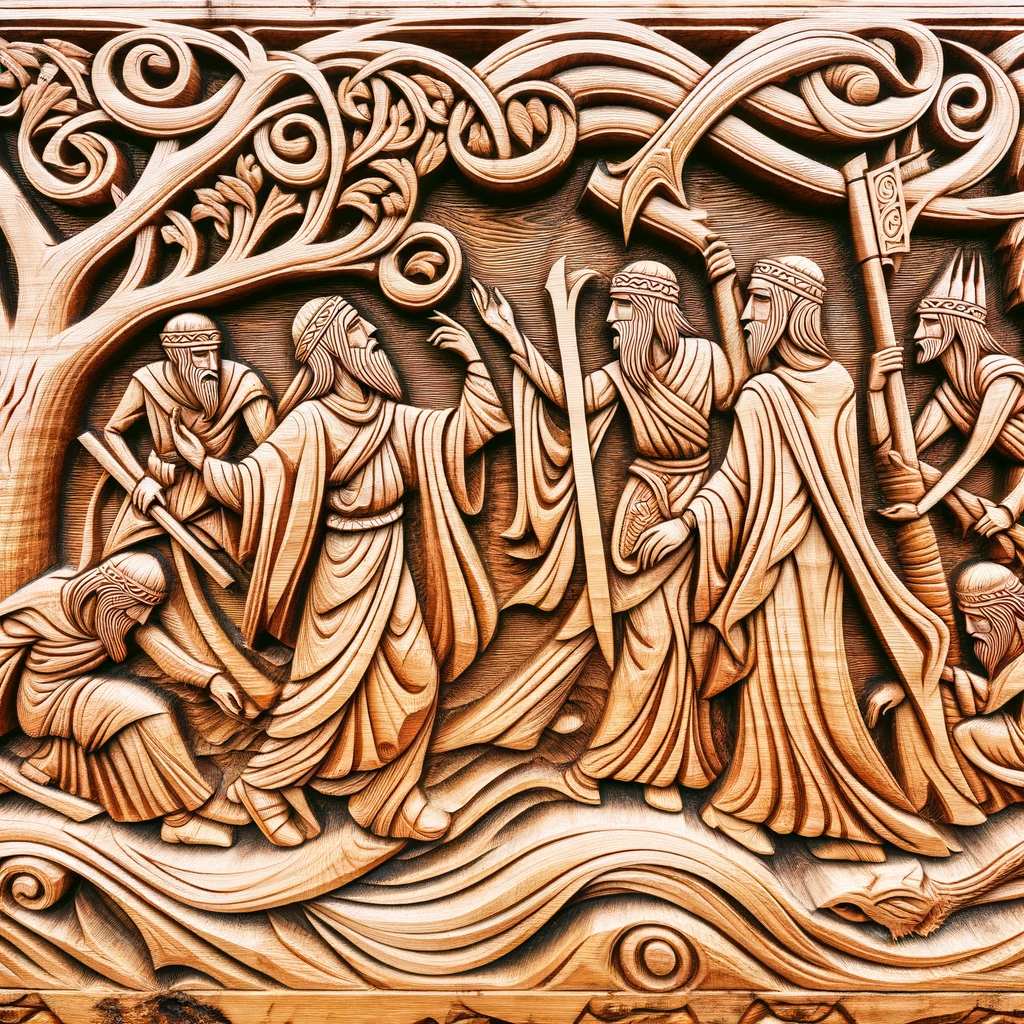Timber, a material as old as civilization itself, has played a pivotal role in shaping human history. From the construction of the earliest shelters to the crafting of tools, timber’s versatility and accessibility have made it an indispensable resource throughout the ages. This article delves into the historical roots of timber, exploring its fundamental role in the development of mankind and its enduring significance in modern times.
 Add My Company
Add My Company

The Dawn of Timber Use
The journey of timber in human history is profound. Archaeological evidence suggests that timber has been a primary construction material for over 10,000 years, dating back to ancient civilizations such as the Romans and Egyptians. The versatility of timber was recognized early on as it was used in everything from building homes to crafting ships. “”

Timber in Ancient Civilizations
- Roman Empire: Timber played a crucial role in ancient Rome, both in construction and as a fuel source for metallurgy. However, extensive use led to severe deforestation, prompting the Romans to import timber from other parts of their empire.
- China: Timber shortages in ancient China emerged as early as the 13th century due to rapid population growth. Despite this, China’s ingenuity in shipbuilding with timber was remarkable.
- Latin and Greek: In ancient Rome and Greece, timber was referred to as “lignum” and “xylon,” respectively. These terms underscored the material’s significance in building and craftsmanship.
- Venice: Known for its maritime prowess, Venice’s shipbuilding industry heavily relied on timber. By the end of the 15th century, the city faced timber shortages, highlighting the resource’s significance in maritime history.

Timber’s Linguistic Journey
The word “timber” has diverse origins and meanings across cultures, reflecting its global importance. For instance, the earliest terms for timber can be traced back to languages of ancient civilizations.
- Lignum: Latin – Used in ancient Rome, “lignum” was the term for wood or timber, reflecting its significance in construction and craftsmanship.
- Xylon: Greek – In ancient Greece, timber or wood was referred to as “xylon.” This term is foundational in many scientific words related to wood and plants.
- Holz: Germanic – In German and other Germanic languages, “holz” means wood or timber, illustrating the material’s importance and ubiquity in these cultures.
- Mokuzai: Japanese – The Japanese word for wood or timber, “mokuzai” (木材), has been used for centuries, reflecting the long-standing tradition of woodworking and timber use in Japan.
- Timber: Old English – Derived from the Old English “timber,” meaning building material and structure, this term highlights the primary use of wood in construction during those times.
- Lakdi: Hindi – In Hindi, “लकड़ी” (lakdi) is the common term for wood or timber, used widely across North India.
- Dāru: Sanskrit – The ancient language of Sanskrit uses the word “दारु” (dāru) for wood or timber. Many Indian languages have derived their terms for wood from Sanskrit.
- Madera: Spanish – In Spanish, the word “madera” is used for wood or timber. Spanish is widely spoken in South America due to historical colonization.
- Pau: Portuguese – In Brazilian Portuguese, which is spoken in Brazil, “pau” refers to wood or a wooden stick. It’s a common term in Brazil’s rich timber industry.
Timber in Modern Society
In modern times, the role of timber has evolved but remains crucial. Today, timber is not just a construction material but a symbol of environmental sustainability. Its role in carbon dioxide neutralization and as a renewable resource underscores the need for responsible forestry practices.
Timber’s Modern Applications
- Construction: Modern construction techniques, such as Cross-Laminated Timber (CLT), showcase timber’s adaptability and sustainability.
- Environmental Impact: With a 13% reduction in global forest areas over the past 6000 years, the responsible use of timber is more important than ever to combat climate change and preserve biodiversity.
The Evolution of Timber Technology
As we continue our journey through the history of timber, we delve into the technological advancements that have transformed its usage, enhancing its properties and expanding its applications.
Timber’s Technological Transformation
From ancient hand tools to modern machinery, the evolution of timber technology is a testament to human ingenuity. Each advancement has allowed us to utilize timber in more efficient and innovative ways.
Ancient Innovations
- Stone Age Tools: In the Stone Age, timber was combined with stone to create more effective tools. Wood served as handles for stone axes and spears, demonstrating early human creativity in maximizing resources.
- Roman Engineering: The Romans were masters of timber engineering, using it in the construction of bridges, aqueducts, and large buildings. Their understanding of timber’s strength and flexibility was crucial in their architectural successes.
Modern Timber Technologies
- Cross-Laminated Timber (CLT): CLT represents a significant modern advancement in timber technology. By layering and bonding timber sections, CLT offers enhanced strength and stability, making it a popular choice in contemporary construction.
- Glue Laminated Timber (Glulam): Glulam is another innovative use of timber, where layers of timber are bonded with durable adhesives. This technology allows for large, strong, and flexible timber structures, pushing the boundaries of architectural design.

The Aesthetics of Timber
The beauty of timber has always been appreciated, from ancient carvings to modern furniture design. Each timber species offers unique colours, grains, and textures, making timber a favoured material for artists and designers alike.
Art and Design with Timber
- Cultural Significance: In many cultures, timber has been used for artistic expression, from Native American totem poles to intricate Japanese joinery.
- Modern Design: Today, the natural aesthetic of timber is celebrated in interior design, furniture making, and architectural elements. Its versatility allows for a range of styles, from rustic to contemporary.
Timber’s Environmental Impact and Future
As we look to the future, the sustainability of timber is a growing concern. With deforestation and environmental degradation, responsible timber sourcing and usage have become critical.
Sustainable Timber Practices
- Eco-Friendly Wood: Choosing sustainably sourced timber is vital for protecting our forests. This includes using certified timber and supporting practices that promote forest regeneration.
- Innovations in Forestry: Modern forestry practices aim to balance timber production with environmental conservation. This includes selective logging, reforestation, and managing forests for biodiversity.
Timber’s Future Prospects
- Renewable Resource: Timber remains a renewable resource when managed responsibly. Its role in carbon sequestration and as a sustainable building material makes it a key player in combating climate change.
- Advancements in Timber Technology: Future innovations in timber technology promise to enhance its properties, making it an even more versatile and sustainable material.
The Cultural Tapestry and Linguistic Roots of Timber
Timber in Mythology and Culture
Throughout history, timber has not only been a material resource but also a rich source of cultural and spiritual significance. Many mythologies and folklore tales are steeped in the reverence of trees and wood.
Mythological Significance
- Norse Mythology: In Norse legends, the world tree Yggdrasil, an immense and central sacred ash tree, connects the nine worlds. Its symbolism is deeply rooted in the cosmology of Norse culture.
- Celtic Traditions: In Celtic culture, trees were venerated and considered to be the abode of spirits and gods, with each tree type having its own symbolism and attributes.

Evolution of the Term
- Old English: The word ‘timber’ in Old English, ‘timber’, had connotations of building material and structure, signifying its importance in construction.
- Romance Languages: In Romance languages like Spanish and Italian, terms like ‘madera’ and ‘legno’ are used for wood, illustrating the diverse linguistic evolution across cultures.
Timber in the Modern World: Applications and Sustainability
Contemporary Uses of Timber
Timber’s role has expanded in modern times, finding applications in various fields while maintaining its traditional uses.
Modern Applications
- Architecture and Design: Timber is widely used in modern architecture for its aesthetic appeal and structural properties. It’s a key material in sustainable building designs.
- Technology and Innovation: The use of timber in technology, from furniture making to engineered wood products, highlights its versatility and adaptability.
Sustainability and the Future of Timber
In the face of environmental challenges, sustainable management of timber resources is crucial.
Sustainable Practices
- Eco-friendly Sourcing: Emphasizing the use of sustainably sourced timber is key to preserving forests and biodiversity.
- Innovation in Forestry: Technological advancements in forestry aim to ensure sustainable production while minimizing environmental impact.
Timber’s Legacy in Art and Future Innovations
Artistic Expressions with Timber
Timber’s influence extends into the realm of art, where its natural beauty and versatility have inspired countless works over the centuries.
Timber in Art
- Sculpture and Carving: Timber has been a preferred medium for sculptors and carvers, prized for its malleability and organic warmth. From the intricate carvings of ancient civilizations to contemporary wooden sculptures, timber continues to be a canvas for artistic expression.
- Craftsmanship and Folk Art: Timber’s role in craftsmanship and folk art showcases cultural histories and traditions. Artisanal crafts such as furniture, toys, and decorative items reflect the deep connection between timber and cultural heritage.
Timber’s Role in Future Innovations
As we look ahead, the potential for timber in technological and environmental advancements is vast.
Potential for Innovation
- Bio-based Materials: Research into bio-based materials is exploring the use of timber in sustainable alternatives to plastics and other environmentally harmful substances.
- Timber in Technology: The integration of timber with new technologies, such as 3D printing and nanotechnology, holds promise for innovative applications in various industries.
Conclusion: Timber’s Timeless Impact
Timber’s journey from ancient forests to modern cityscapes tells a story of enduring relevance and adaptability. Its role in human history is not just a testament to its practicality but also a reflection of our relationship with the natural world. As we forge ahead, embracing sustainable practices and innovative uses, timber remains a vital link between our past and our future, shaping the way we live, build, and dream.
Discover the timeless beauty and innovative potential of Timber, and be a part of its ongoing story.
For more information on Timber Through The Ages: A Legacy Carved in Wood talk to Coventry Timber Products Ltd
